Transylvania (Twice)
They struck me as minor travels when I took them, but now that no one can travel much of anywhere, they seem as worthy of writing about as anything. Last year, I took two separate trips to Romania just weeks apart -- the first, during the week-long break from school in November, with Oya, Julia and "Dede" (Grandpa) Hüseyin, and the other in December with a group of students from school.
November
We boarded an early-morning bus to Plovdiv, Bulgaria and were there by early afternoon. The ride up was uneventful, but when we got there, we needed to stretch our legs and walked all the way from Yug bus station through the sad, Soviet-looking area, then up the pedestrian walkway through the pretty new town to the incomparably charming Hebros Hotel in the old town, where Oya and I had stayed the last time we were there, in 2012. This was my third time in Plovdiv (the first was in 2006), and nothing had changed. I wasn't there to see anything new, though. Mostly I wanted to retrace my footsteps and jog my memory. It is one of those small cities that I have more or less memorized. We spent two days poking around antique shops, drinking the local wine, visiting the Roman amphiteater and the house museums -- the usual. Our final morning, Julia and I took a walk up to the top of Nebet Tepe and took a look at the Ethnographic Museum, where I was especially interested in a display of silver and mother-of-pearl belt clasps.
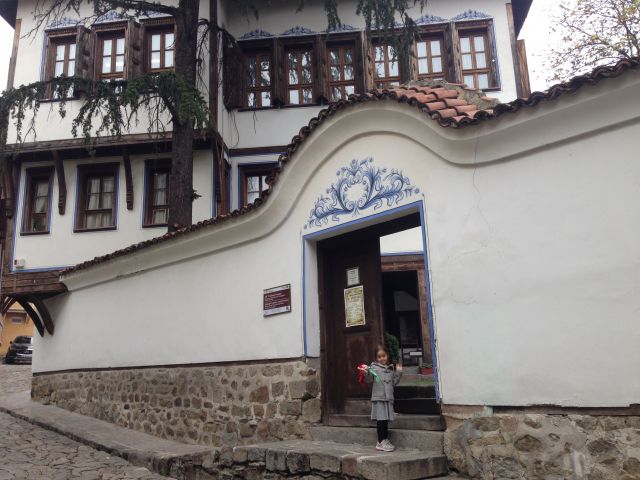
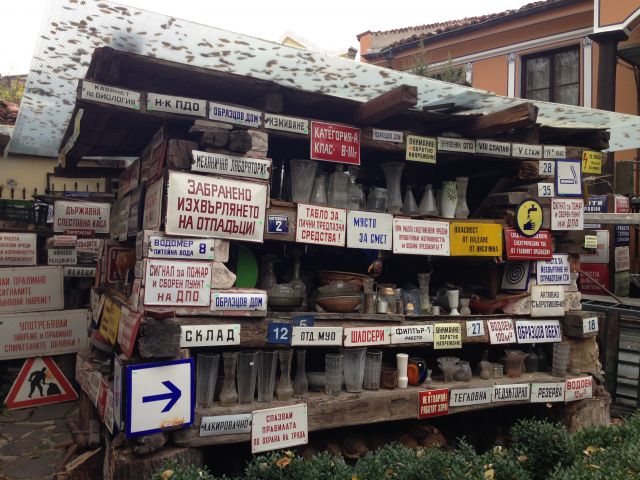
Dede had some business in Stara Zagora, a short train ride away, where he was in the process of becoming a resident, and so we took a one-hour train ride and spent the night there. In the morning, while he sorted out his business, we spent a few hours exploring the town, which has a more modern layout than anywhere else I've seen in Bulgaria, with wide boulevards and parks everywhere. By afternoon, his appointments were over, and he had borrowed a car from his friend, and we were ready for the real journey.
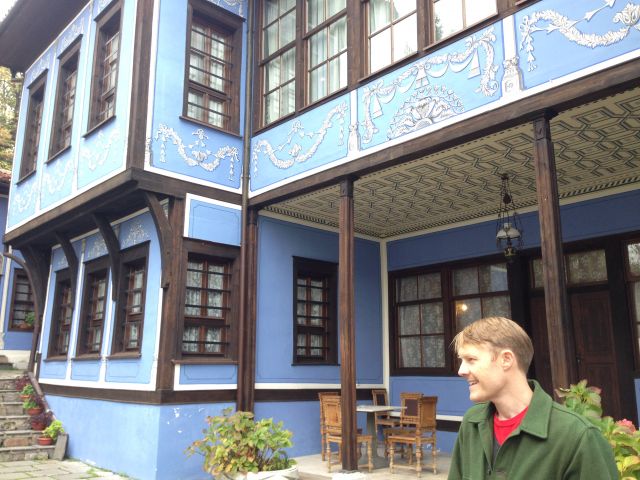
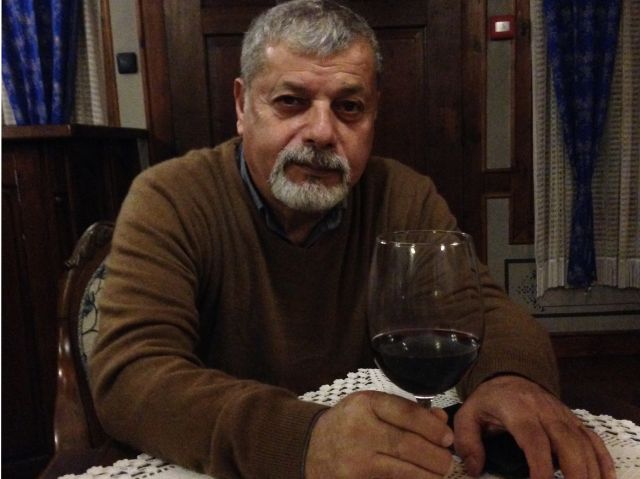
Hüseyin lived in Romania more than twenty years ago and has told us stories about it as long as I've known him. He claimed to speak Romanian, but I wasn't able to test him until a few years ago when we had a Romanian visitor, who said he spoke well. We headed north, through the pass at Mt. Shipka and over the Romanian border after nightfall. It was raining and dark except for spotlights at the border. Customs agents walked from car to car in rain slickers, which lent a tension to the crossing that I didn't expect between two European countries. By the time we hit Bucharest, it was late, and we stopped at a nondescript hotel and went directly to sleep.
The area we had in mind all along was Transylvania. When we initially told Dede to take us there, he explained that it was a massive region, about one-third of the country. We settled on Braşov, at the very southern edge of the region, which I was scheduled to return to for a school field trip in December. It would be a reconnaisance mission. The research I had done on the region had pulled up one of the largest salt mines in Europe, a bear sanctuary, and "the best road in the world" (according to Top Gear) -- the impossibly twisty Transfagaraşan highway. I had convinced Dede to take us on the highway, but as the day got foggier, he suggested we put it off for a summer visit.

As we entered Transylvania, the landscape began to change. At one point, stopped on the highway that ran through the center of a small town where some roadwork was happening, I watched an old man with a mustache trimmed so that it appeared like a pair of fangs walk down the long line of cars toward us, only to realize that he was carrying a hatchet in one hand. As we got into more rural territory, we followed a high road along a ridge, past farmhouses and bare trees. The leaves on the forest floor were red, and the forest had a foreboding feeling. One strange thing I saw alongside the roads again and again were haystacks with pitchforks stuck into their tops. The only people I saw were old.
When we got to Braşov, it was already dark (the sun set by 4:40 PM). We drove into the old town and up to the Bella Muzica Hotel. I booked us in the best room at the best hotel in the city, because in Romania I could afford it. We had a suite with two floors -- the upstairs with a slanted ceiling and exposed wooden beams. We had a traditional Transylvanian dinner just down the street (including my first taste of Romanian tripe) and then walked around the old town square. Christmas decorations were just going up, and the square had the feeling of a festival about to start. At the center of the old town is the mysterious Black Church, a Gothic structure that got its name after suffering fire damage 300 years ago. Every time I tried to enter the church, it was closed for one reason or another -- outside of regular hours, a baptism, etc. Talking to the receptionist at our hotel it came out that nearly all the property in the area was owned by the Black Church, and the place began to take on a clandestine character.
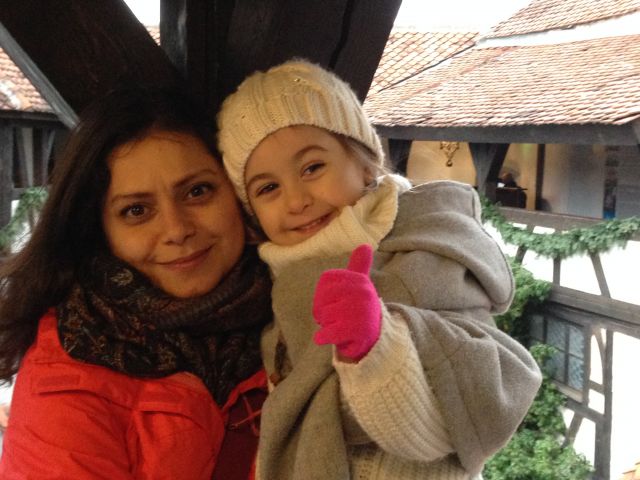
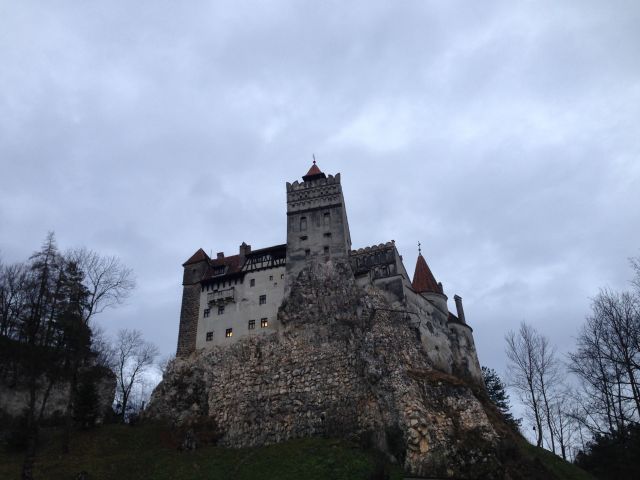
The next morning we headed out to the bear sanctuary, an area of fenced woodland where bears that had been rescued from circuses and restaurants across Europe were being rehabilitated. At one point I looked up to find two bears in a tree above me. Part of the bear sanctuary was distinctly sad. One bear that had come from a circus would stand on its hind legs and do a pirouette every time a person passed it, it had been so conditioned to entertain. That afternoon we went to Bran Castle, the famous "Dracula Castle," which is the star attraction of the region. Bran, which is mostly a tourist town serving the castle, is full of stands selling wooden hand-carved souvenirs, along with the odd antiques shop, but more about that later. The castle is a foreboding thing, built high on a rock, the entrance gained by a set of steep steps. The several roofs are pitched at odd angles, and there is one wall with a sheer face that extends at least 60 feet above the rock. Since I knew I would return here with my students, my main order of business was to collect enough details from the castle to create a scavenger hunt for their visit. I photographed every corner of the place and read every placard. The disappointing thing I came to find was that Vlad the Impaler (the historical inspiration for Count Dracula) had only the most tenuous connection to the place and definitely never lived there. There were some great details about vampires, strigoi and other Transylvanian demons, though. The castle is not exactly frightening, and with the fir boughs strung on every balcony, it looked almost Christmas-y, but it is one of the most meandering buildings I have every been in, with at least six levels plus a deep couryard, all connected with innumberable steps-up and steps-down.
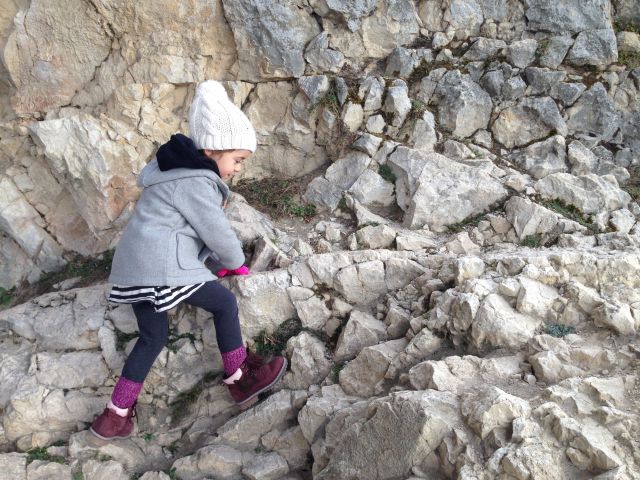
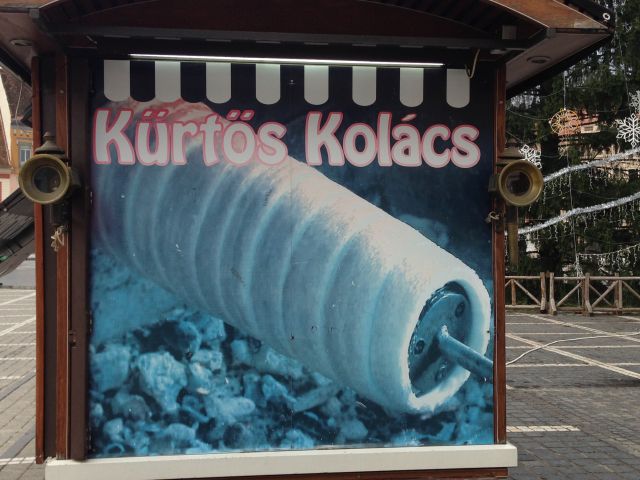
We took one more trip in the area of Braşov the following day, to Raşnov Fortress. An amusing detail of both Braşov and Raşnov is that they have huge white, illuminated signs reading their names on the hills overhead, in the same font as the Hollywood sign. Raşnov is reached from a gondola on one side or by foot on the other. We took the long walk up, but before we started up fueled ourselves with a hot kürtőskalács -- a funnel cake with a Hungarian name. We watched them make it from scratch, which involved wrapping dough over thick wooden dowels and cooking them over coals. When they were brown, they were sprinkled with sugar and walnuts. Before we entered the gates of the fortress we bought cups of hot mulled wine (sold absolutely everywhere in Transylvania this time of year, it seems). Inside the walls are the remains of a city, but it is difficult to walk through due to stones sticking out of the ground everywhere, and the best parts of being there were climbing up the old walls and the view of the snow-capped Carpathian Mountains. We left Romania that night after a drive south through the pretty resort town of Sinaia and then the sunless roads toward the Bucharest airport.
December
I had planned a field trip to Transylvania with my 9th graders in 2018, to tie in with our yearly horror unit, but I couldn't drum up enough interest. In 2019, however, I found 22 students who were interested. Upon landing in Bucharest on Friday the 13th, we equipped each student with a small head of garlic and their "survival guide" at the airport and were off. We traveled by bus from Bucharest toward Braşov, stopping at the town of Sinaia on the way north, to visit a monastery and the immense Peleş Castle. Peleş turned out to be more than just a castle, with immense gardens, covered in snow. The grounds had numerous terraces, with long stone balustrades, newels capped with massive stone-ball finials. We trudged through the slush to the castle entrance, statues poking through a sea of fog. It was as atmospheric a beginning to the trip as I could have hoped for. The castle interior had all kinds of ornate woodwork and halls displaying arms. My impression was of a gratuitous structure built long after the era of building castles had ended. Before leaving Sinaia, we stopped at the monastery. After looking at the frescoes, the students loaded up on religious paraphernalia at the gift kiosk inside. I picked up a wooden cross for further protection against the undead.
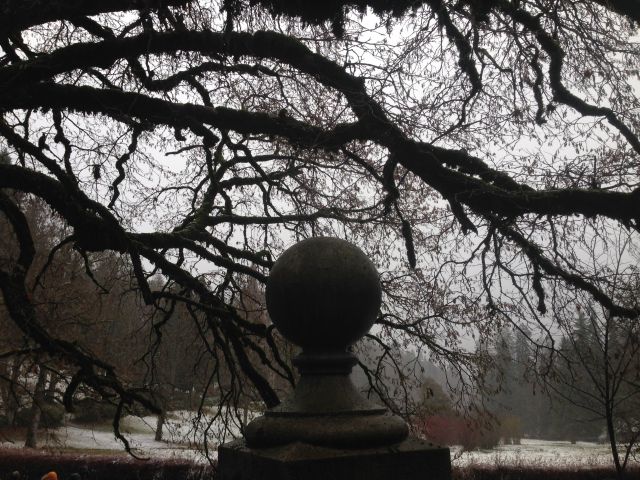
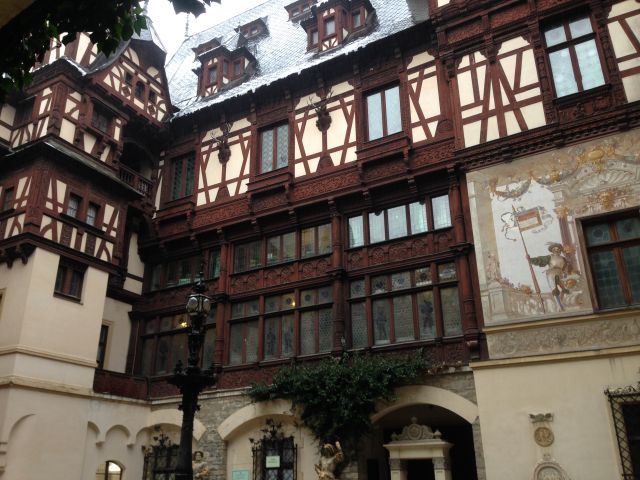
In the month between my first and second trip to Transylvania, the seasons had turned. The forests which had been full of red leaves were now even more forlorn, with nothing but bare branches. The Christmas decorations, however, were up, and the 40-foot tree in the central square of Braşov was lit. Our hotel was a bit outside the town, and in the morning, in the breakfast room, we could see views of the valleys and mountains in every direction. The days were short, with the sun going down by about four o'clock in the afternoon. We spent part of a day at Bran Castle, where the students did the scavenger hunt I had prepared. Since I had seen it all before, I poked around the shops out front. I bought a hand-carved slide whistle for Julia and a small wooden trunk which she now uses to hold her "treasures." A few of the students asked if I would walk with them to a small shop they had seen across the road when we first arrived in the town. It was no more than a shack but was chock-full with piles of old army helmets, boards covered in military medals and pocketwatches, a glass case full of rings and outdated currency. I almost bought an album full of someone's old family photographs just for the album, which struck me for some reason I no longer remember, but I have a rule against buying useless stuff and passed on it in the end.
We spent an hour or so at a ski resort nearby, where we missed the gondola to the top and ended up walking up the ski slopes for a while. I had the misfortune of slipping on the ice and breaking the little slide-whistle in my pocket. We took a walking tour of parts of Braşov outside the center, but our tour guide had a strange habit of stopping in front of places that seemed interesting, telling us all the important dates connected with them and then not taking us inside. We filled our evenings at our hotel with a horror-story telling contest and some other gruesome games, including the terrifying "red book," for which we used Rider Haggard's She to gain guidance from the spirit world. At night, I had to stay up about an hour past their curfew, making sure students weren't sneaking into one another's rooms, but for the most part they were an easy group.
 Our final morning in Braşov, we took the gondola to the top of Mt. Tampa and looked back over the city from behind the Hollywood-style sign at the top. On the bus trip back to Bucharest, a group of kids insisted on me joining them for games like listing Nirvana songs that started with different letters of the alphabet until someone choked and was "out" (there are none that start with the letter "K," by the way). We had a few hours in Bucharest before our flight and took a last walking tour, but I didn't have much interest in a big city after our days surrounded by moutains and forests.
Our final morning in Braşov, we took the gondola to the top of Mt. Tampa and looked back over the city from behind the Hollywood-style sign at the top. On the bus trip back to Bucharest, a group of kids insisted on me joining them for games like listing Nirvana songs that started with different letters of the alphabet until someone choked and was "out" (there are none that start with the letter "K," by the way). We had a few hours in Bucharest before our flight and took a last walking tour, but I didn't have much interest in a big city after our days surrounded by moutains and forests.
When I got home, Oya and I talked about returning to Romania in the summer. Of course, that never happened.
November
We boarded an early-morning bus to Plovdiv, Bulgaria and were there by early afternoon. The ride up was uneventful, but when we got there, we needed to stretch our legs and walked all the way from Yug bus station through the sad, Soviet-looking area, then up the pedestrian walkway through the pretty new town to the incomparably charming Hebros Hotel in the old town, where Oya and I had stayed the last time we were there, in 2012. This was my third time in Plovdiv (the first was in 2006), and nothing had changed. I wasn't there to see anything new, though. Mostly I wanted to retrace my footsteps and jog my memory. It is one of those small cities that I have more or less memorized. We spent two days poking around antique shops, drinking the local wine, visiting the Roman amphiteater and the house museums -- the usual. Our final morning, Julia and I took a walk up to the top of Nebet Tepe and took a look at the Ethnographic Museum, where I was especially interested in a display of silver and mother-of-pearl belt clasps.


Dede had some business in Stara Zagora, a short train ride away, where he was in the process of becoming a resident, and so we took a one-hour train ride and spent the night there. In the morning, while he sorted out his business, we spent a few hours exploring the town, which has a more modern layout than anywhere else I've seen in Bulgaria, with wide boulevards and parks everywhere. By afternoon, his appointments were over, and he had borrowed a car from his friend, and we were ready for the real journey.


Hüseyin lived in Romania more than twenty years ago and has told us stories about it as long as I've known him. He claimed to speak Romanian, but I wasn't able to test him until a few years ago when we had a Romanian visitor, who said he spoke well. We headed north, through the pass at Mt. Shipka and over the Romanian border after nightfall. It was raining and dark except for spotlights at the border. Customs agents walked from car to car in rain slickers, which lent a tension to the crossing that I didn't expect between two European countries. By the time we hit Bucharest, it was late, and we stopped at a nondescript hotel and went directly to sleep.
The area we had in mind all along was Transylvania. When we initially told Dede to take us there, he explained that it was a massive region, about one-third of the country. We settled on Braşov, at the very southern edge of the region, which I was scheduled to return to for a school field trip in December. It would be a reconnaisance mission. The research I had done on the region had pulled up one of the largest salt mines in Europe, a bear sanctuary, and "the best road in the world" (according to Top Gear) -- the impossibly twisty Transfagaraşan highway. I had convinced Dede to take us on the highway, but as the day got foggier, he suggested we put it off for a summer visit.

As we entered Transylvania, the landscape began to change. At one point, stopped on the highway that ran through the center of a small town where some roadwork was happening, I watched an old man with a mustache trimmed so that it appeared like a pair of fangs walk down the long line of cars toward us, only to realize that he was carrying a hatchet in one hand. As we got into more rural territory, we followed a high road along a ridge, past farmhouses and bare trees. The leaves on the forest floor were red, and the forest had a foreboding feeling. One strange thing I saw alongside the roads again and again were haystacks with pitchforks stuck into their tops. The only people I saw were old.
When we got to Braşov, it was already dark (the sun set by 4:40 PM). We drove into the old town and up to the Bella Muzica Hotel. I booked us in the best room at the best hotel in the city, because in Romania I could afford it. We had a suite with two floors -- the upstairs with a slanted ceiling and exposed wooden beams. We had a traditional Transylvanian dinner just down the street (including my first taste of Romanian tripe) and then walked around the old town square. Christmas decorations were just going up, and the square had the feeling of a festival about to start. At the center of the old town is the mysterious Black Church, a Gothic structure that got its name after suffering fire damage 300 years ago. Every time I tried to enter the church, it was closed for one reason or another -- outside of regular hours, a baptism, etc. Talking to the receptionist at our hotel it came out that nearly all the property in the area was owned by the Black Church, and the place began to take on a clandestine character.


The next morning we headed out to the bear sanctuary, an area of fenced woodland where bears that had been rescued from circuses and restaurants across Europe were being rehabilitated. At one point I looked up to find two bears in a tree above me. Part of the bear sanctuary was distinctly sad. One bear that had come from a circus would stand on its hind legs and do a pirouette every time a person passed it, it had been so conditioned to entertain. That afternoon we went to Bran Castle, the famous "Dracula Castle," which is the star attraction of the region. Bran, which is mostly a tourist town serving the castle, is full of stands selling wooden hand-carved souvenirs, along with the odd antiques shop, but more about that later. The castle is a foreboding thing, built high on a rock, the entrance gained by a set of steep steps. The several roofs are pitched at odd angles, and there is one wall with a sheer face that extends at least 60 feet above the rock. Since I knew I would return here with my students, my main order of business was to collect enough details from the castle to create a scavenger hunt for their visit. I photographed every corner of the place and read every placard. The disappointing thing I came to find was that Vlad the Impaler (the historical inspiration for Count Dracula) had only the most tenuous connection to the place and definitely never lived there. There were some great details about vampires, strigoi and other Transylvanian demons, though. The castle is not exactly frightening, and with the fir boughs strung on every balcony, it looked almost Christmas-y, but it is one of the most meandering buildings I have every been in, with at least six levels plus a deep couryard, all connected with innumberable steps-up and steps-down.


We took one more trip in the area of Braşov the following day, to Raşnov Fortress. An amusing detail of both Braşov and Raşnov is that they have huge white, illuminated signs reading their names on the hills overhead, in the same font as the Hollywood sign. Raşnov is reached from a gondola on one side or by foot on the other. We took the long walk up, but before we started up fueled ourselves with a hot kürtőskalács -- a funnel cake with a Hungarian name. We watched them make it from scratch, which involved wrapping dough over thick wooden dowels and cooking them over coals. When they were brown, they were sprinkled with sugar and walnuts. Before we entered the gates of the fortress we bought cups of hot mulled wine (sold absolutely everywhere in Transylvania this time of year, it seems). Inside the walls are the remains of a city, but it is difficult to walk through due to stones sticking out of the ground everywhere, and the best parts of being there were climbing up the old walls and the view of the snow-capped Carpathian Mountains. We left Romania that night after a drive south through the pretty resort town of Sinaia and then the sunless roads toward the Bucharest airport.
December
I had planned a field trip to Transylvania with my 9th graders in 2018, to tie in with our yearly horror unit, but I couldn't drum up enough interest. In 2019, however, I found 22 students who were interested. Upon landing in Bucharest on Friday the 13th, we equipped each student with a small head of garlic and their "survival guide" at the airport and were off. We traveled by bus from Bucharest toward Braşov, stopping at the town of Sinaia on the way north, to visit a monastery and the immense Peleş Castle. Peleş turned out to be more than just a castle, with immense gardens, covered in snow. The grounds had numerous terraces, with long stone balustrades, newels capped with massive stone-ball finials. We trudged through the slush to the castle entrance, statues poking through a sea of fog. It was as atmospheric a beginning to the trip as I could have hoped for. The castle interior had all kinds of ornate woodwork and halls displaying arms. My impression was of a gratuitous structure built long after the era of building castles had ended. Before leaving Sinaia, we stopped at the monastery. After looking at the frescoes, the students loaded up on religious paraphernalia at the gift kiosk inside. I picked up a wooden cross for further protection against the undead.


In the month between my first and second trip to Transylvania, the seasons had turned. The forests which had been full of red leaves were now even more forlorn, with nothing but bare branches. The Christmas decorations, however, were up, and the 40-foot tree in the central square of Braşov was lit. Our hotel was a bit outside the town, and in the morning, in the breakfast room, we could see views of the valleys and mountains in every direction. The days were short, with the sun going down by about four o'clock in the afternoon. We spent part of a day at Bran Castle, where the students did the scavenger hunt I had prepared. Since I had seen it all before, I poked around the shops out front. I bought a hand-carved slide whistle for Julia and a small wooden trunk which she now uses to hold her "treasures." A few of the students asked if I would walk with them to a small shop they had seen across the road when we first arrived in the town. It was no more than a shack but was chock-full with piles of old army helmets, boards covered in military medals and pocketwatches, a glass case full of rings and outdated currency. I almost bought an album full of someone's old family photographs just for the album, which struck me for some reason I no longer remember, but I have a rule against buying useless stuff and passed on it in the end.
We spent an hour or so at a ski resort nearby, where we missed the gondola to the top and ended up walking up the ski slopes for a while. I had the misfortune of slipping on the ice and breaking the little slide-whistle in my pocket. We took a walking tour of parts of Braşov outside the center, but our tour guide had a strange habit of stopping in front of places that seemed interesting, telling us all the important dates connected with them and then not taking us inside. We filled our evenings at our hotel with a horror-story telling contest and some other gruesome games, including the terrifying "red book," for which we used Rider Haggard's She to gain guidance from the spirit world. At night, I had to stay up about an hour past their curfew, making sure students weren't sneaking into one another's rooms, but for the most part they were an easy group.
 Our final morning in Braşov, we took the gondola to the top of Mt. Tampa and looked back over the city from behind the Hollywood-style sign at the top. On the bus trip back to Bucharest, a group of kids insisted on me joining them for games like listing Nirvana songs that started with different letters of the alphabet until someone choked and was "out" (there are none that start with the letter "K," by the way). We had a few hours in Bucharest before our flight and took a last walking tour, but I didn't have much interest in a big city after our days surrounded by moutains and forests.
Our final morning in Braşov, we took the gondola to the top of Mt. Tampa and looked back over the city from behind the Hollywood-style sign at the top. On the bus trip back to Bucharest, a group of kids insisted on me joining them for games like listing Nirvana songs that started with different letters of the alphabet until someone choked and was "out" (there are none that start with the letter "K," by the way). We had a few hours in Bucharest before our flight and took a last walking tour, but I didn't have much interest in a big city after our days surrounded by moutains and forests.When I got home, Oya and I talked about returning to Romania in the summer. Of course, that never happened.
Don't miss what's next. Subscribe to Ned Entrikin's Travels: